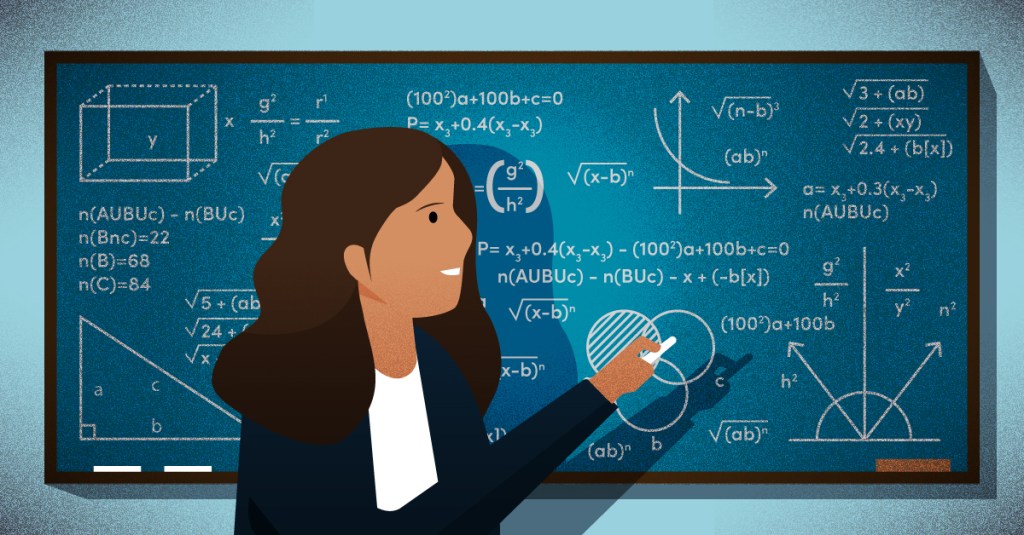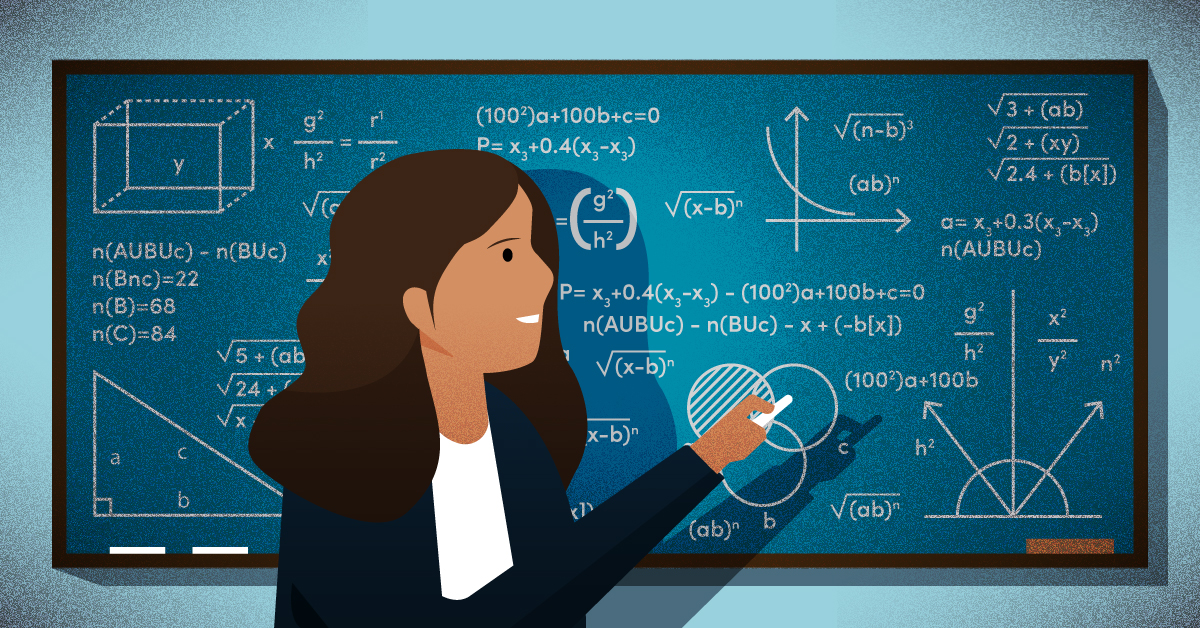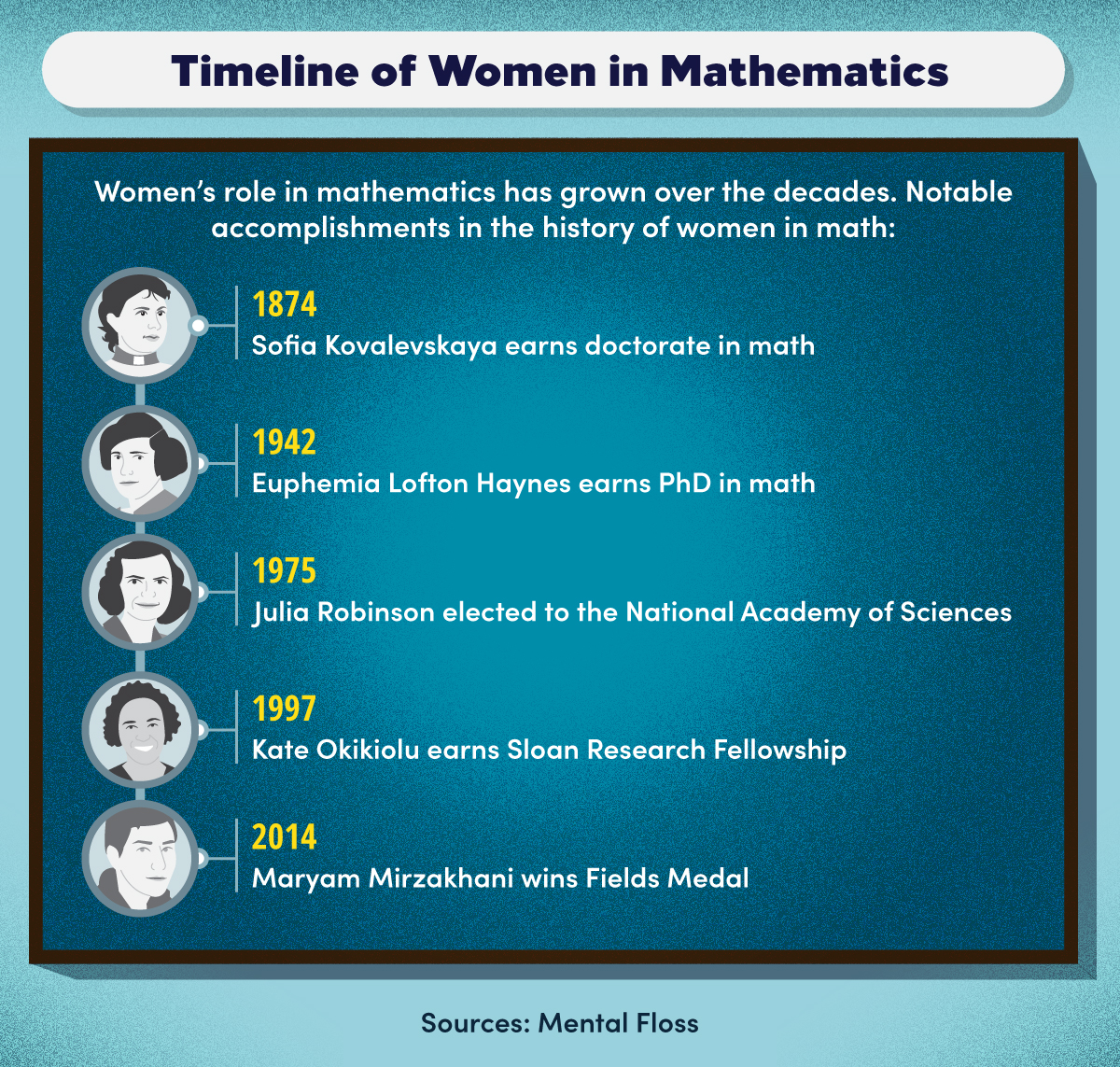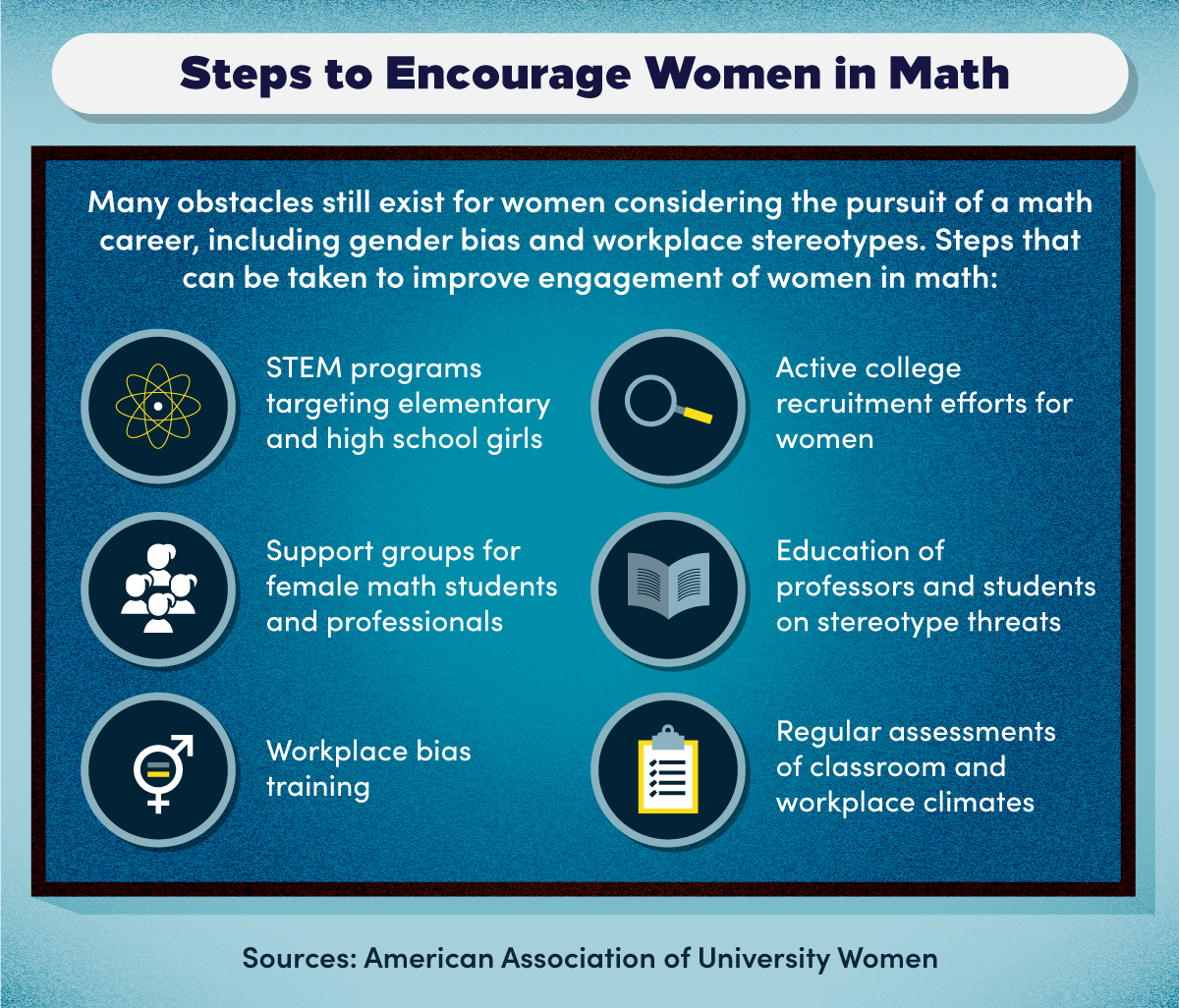Guide for Women in Mathematics: History, Scholarships, and Career Potential

Tables of Contents
The accomplishments of men have historically dominated the conversation in the field of mathematics. The disparity isn’t as pronounced as it once was, but the fact remains that even today, women in mathematics remain radically underrepresented.
The 2016 film “Hidden Figures” tells the story of the African American women whose math skills helped propel the U.S. into space in the 1960s. It says a lot that it took more than 50 years for their vital work to gain the widespread recognition it deserves.
It also speaks volumes that the authors chose the word “hidden” to describe the historic achievements of these remarkable mathematicians. According to “Why Are There So Few Women in Mathematics?,” a 2016 article in The Atlantic magazine, a big reason women remain largely on the periphery of mathematics in academia is a “corrosive” culture that favors male leadership.
This article examines the history of women in mathematics, with a deeper look at the obstacles that women have faced in the field over the centuries, as well as the progress that’s been made toward gender equity.
It also explores the wealth of scholarship and career opportunities available to women in mathematics.

History of Women in Mathematics
The field of mathematics has historically been dominated by men. Their names are famous: Euclid, the founder of geometry; Pythagoras, whose theorem explains how to determine the area of a right triangle; Archimedes, who discovered pi.
Well-known scientists like Albert Einstein (time and relativity) and Alan Turing (computer science) carried the torch in the 20th century. Meanwhile, even though math as a field of study remained largely closed to women, many women made significant contributions to algebra, geometry, theoretical math, and other areas of study.
Despite this, the gender gap in math persists across the professional spectrum of education and science. According to a study by the National Science Foundation, women accounted for only 28.5% of doctorates awarded in mathematics in the U.S. in 2016. This was a 4% increase from 1997 (24.1%), but a 1% decrease from 2006 (29.6%).
Headway has been made toward gender equity in math, but there’s still work to do.
Hypatia of Alexandria: One of the First Female Mathematicians
One of the earliest known women to make a major contribution to the field of mathematics was the Greek philosopher and educator Hypatia of Alexandria. She was born around 350, was an avowed paganist, and was killed by rioting monks in 415 or 416.
While none of her work survived the burning of the Library of Alexandria, subsequent writings about her credited her or her Neoplatonic students with inventing vital measurement, observation, and navigation tools, such as the plane astrolabe, the graduated brass hydrometer, and the hydroscope.
According to the ThoughtCo encyclopedic entry on Hypatia of Alexandria, she’s believed to have lectured on and written about the motions of the planets, number theory, and conic sections.
She’s become a symbol of feminism. Her unsuccessful effort to preserve the knowledge contained in the ancient library was the subject of the 2009 movie “Agora,” starring British-born actor Rachel Weisz as Hypatia.
Hypatia of Alexandria: Resources
Gradual Progress
During the Renaissance and Age of Enlightenment, mathematical, scientific, and artistic advancements of men, such as Nicolaus Copernicus, Rene Descartes, Leonardo da Vinci, Gottfried Wilhelm Leibniz, and Sir Isaac Newton, grabbed the spotlight. As in most academic fields during that time, women had limited access to the tools of learning and research.
During the 1700s and 1800s, a number of women began to make their marks on the field of mathematics. Women published textbooks, conducted groundbreaking research, and translated ancient mathematical works from Latin and Greek.
Not until the 20th century would women be widely accepted as equals in the male-dominated field. In 2019, Karen Uhlenbeck was awarded one of math’s greatest honors, the Abel Prize; this was the first time that a woman had been given this honor. However, even as societal attitudes shifted in the direction of gender equity, many barriers remained for women in mathematics.
Women In Math: By the Numbers
Academic studies and statistical analyses of the gender inequity in math are clear: Female mathematicians remain at a distinct and systemic disadvantage.
According to salary information compiled by the National Science Foundation, female mathematical scientists earned $70,000, on average, in 2017. Men in the same field with comparable experience earned $81,000, meaning for every dollar earned by a male math scientist, a female math scientist earned 86 cents.
A 2018 survey by the American Mathematical Society found that only 31% of math positions in higher education were filled by women, including 30% of all tenure-track positions.
Another indication of the relative lack of agency of women in mathematics is the large gender gap among members of editorial boards of academic journals. According to “Why Are There So Few Women Mathematicians?,” mathematician Chad Topaz and computer scientist Shilad Sen discovered that only 9% of editorial board positions were held by women.
This relative lack of representation among the informational gatekeepers of the field is evidence of ongoing gender disparity in mathematics.
Famous Women in Math
While their names may not be as famous as many of their historical male counterparts, women have left an indelible mark on the field of mathematics. Here’s a brief biographical overview of some of history’s most prominent women in math:
Sophie Germain (1776-1831)
French-born mathematician Sophie Germain is known for her work in elasticity, number theory, and acoustics.
Sofia Kovalevskaya (1850-1891)
Sofia Kovalevskaya was a Russian-born mathematician and equal rights pioneer who expanded the general knowledge of partial differential equations and was the first European woman to earn a doctorate in mathematics. She also was the first woman to serve on the editorial board of a scientific journal and be appointed as a mathematics professor.
Mary Somerville (1780-1872)
Scottish-born polymath Mary Somerville was acknowledged as one of the leading mathematical minds of her time. She was recognized for her work in calculus and astronomy. Somerville College at Oxford University in England is named for her.
Ada Lovelace (1815-1852)
English countess and mathematician Ada Lovelace contributed to the development of early algorithms that are considered to be among the first computer programs. Her analysis of the work compiled by contemporary mathematician Charles Babbage earned her enduring respect in the math world.
Emmy Noether (1882-1935)
German-born mathematician Emmy Noether broke ground on algebraic theorems and researched ring theory, group theory, and more. Upon her death, Albert Einstein praised Noether as “the most significant creative mathematical genius thus far produced since the higher education of women began.”
Julia Robinson (1919-1985)
Julia Robinson is best known for her work to help solve “Hilbert’s 10th problem,” one of 23 puzzling academic challenges issued by the prominent mathematician David Hilbert in 1900. Robinson overcame a childhood marked by illness to become the first woman elected to the mathematics section of the National Academy of Sciences, as well as the first woman to serve as president of the American Mathematical Society.
Maryam Mirzakhani (1977-2017)
Iranian-born Princeton and Stanford researcher Maryam Mirzakhani became the first — and thus far only — woman to be awarded the Fields Medal for mathematical excellence. She was recognized for her groundbreaking work in the fields of dynamics and geometry of Riemann surfaces and moduli spaces.
Karen Uhlenbeck (born 1942)
Karen Uhlenbeck, a University of Texas and Princeton professor, became the first woman to be awarded the Abel Prize for mathematics in 2019. She pioneered breakthroughs in the fields of geometric analysis and gauge theory and has spent her career working to improve the standing of women in mathematics.
Radia Perlman (born 1951)
Radia Perlman is an Internet Hall of Fame inductee and has been a professor at Harvard, the Massachusetts of Technology, and the University of Washington. She is best known for developing the “spanning tree” algorithm that made the internet scalable.

Sofia Kovalevskaya was the first European woman to earn a doctorate in mathematics (1874)
Euphemia Lofton Haynes was the first African American woman to earn a doctorate in mathematics (1942)
Julia Robinson become the first woman elected to the mathematics section of the National Academy of Sciences (1975)
British-born educator and researcher Kate Okikiolu was the first Black woman to be awarded a Sloan Research Fellowship (1997)
Maryam Mirzakhani was awarded the Fields Medal for mathematical excellence (2014)
Women of Color in Mathematics
The sexism that historically prevented all women from achieving gender equity in mathematics has been compounded for women of color by systemic racial discrimination. In addition to having to overcome misogynistic policies, women of color in math must overcome racism.
According to the National Science Foundation’s most recent analysis of the science and engineering labor force, African Americans held 5.7% of jobs occupied by women. That was an increase of only 0.1% from 20 years earlier.
The story was more promising for Asian and Hispanic women. In 2015, Asian women held 22.9% of science and engineering jobs, a significant increase from the 9.8% share they held in 1995. Hispanic women were at 6.4% in 2015 and 2.9% in 1995.
Meanwhile, white women held a 62.9% share in 2015, down from 81.3% in 1995.
The same National Science Foundation analysis showed that women in the field earned an average of $57,000 annually, as opposed to men’s average salary of $86,000. African Americans overall earned an average of $55,000, while whites earned an average of $78,000.
Despite societal and cultural disadvantages, women of color in the U.S. have made significant contributions to mathematics. Here’s a brief biographical overview of some of the most influential and prominent women of color in mathematics:
Euphemia Lofton Haynes (1890-1980)
Washington, D.C. native Euphemia Lofton Haynes was the first African American woman to earn a doctorate in mathematics.
Dorothy Vaughan (1910-2008)
Dorothy Vaughan, a Kansas City, Missouri, native and mathematician, was NASA’s first African American manager. Her story was chronicled in the film “Hidden Figures,” along with those of Katherine Johnson and Mary Jackson.
Katherine Johnson (1918-2020)
West Virginia native and NASA mathematician Katherine Johnson performed trajectory analysis for the first American crewed spaceflight and contributed calculations to many other missions to space. She was awarded the Presidential Medal of Freedom in 2015.
Mary Jackson (1921-2005)
Mary Jackson, a native of Hampton, Virginia, taught at the University of Maryland and served with Dorothy Vaughan and Katherine Johnson as an aeronautical engineer for NASA.
Kate Okikiolu (born 1965)
British-born educator and researcher Kate Okikiolu was the first Black woman to be awarded a Sloan Research Fellowship. She also is the first black woman to be published in the distinguished Princeton journal the Annals of Mathematics.
Scholarships for Women in Math
Women who wish to pursue mathematics as a field of study have many options to help pay for classes, including scholarships, grants, fellowships, and paid internships. Each of these types of financial assistance — including many scholarship programs specifically for women — are available in a number of categories for undergraduate, graduate, doctoral, postdoctoral, and academic tracks.
Various math societies, such as the American Mathematical Society, as well as corporations, the federal government, state and local government agencies, minority support groups, the U.S. military, universities, academic associations, research companies, and other groups offer assistance for qualified individuals.
While most monetary awards are open to all students, regardless of gender, some are specifically created to encourage women to pursue careers in math. Here are a few examples of scholarships intended specifically for women in mathematics:
- American Association of University Women fellowships. AAUW offers American fellowships, career development grants, community development grants, and international fellowships to qualified women in various fields. The organization offers research publication grants in engineering, medicine, and science in the amounts of $10,000-$35,000.
- Association for Women in Mathematics prizes. The AWM offers undergraduate and graduate students a number of prizes based on academic achievement in research, dissertation presentation, and more.
- Joan and Joseph Birman Fellowship for Women Scholars. The Joan and Joseph Birman Fellowship for Women Scholars, a $50,000 award, was created by the Birmans to encourage midcareer women researchers in their work.L’Oreal USA for Women in Science fellowship. French cosmetics company L’Oreal, working with the American Association for the Advancement of Science, awards $60,000 annually to five postdoctoral scientists who are involved in the science, technology, engineering, and math (STEM) fields.

Many obstacles still exist for women considering the pursuit of a math career, including gender bias and workplace stereotypes. Steps that can be taken to improve engagement of women in math:
– STEM programs targeting elementary and high school girls
– Support groups for female math students and professionals
– Workplace bias training
-Active college recruitment efforts for women
– Education of professors and students on stereotype threats
– Regular assessments of classroom and workplace climates
Sources: American Association of University Women
Increase of Women in Math and Science Careers
According to the U.S. Bureau of Labor Statistics (BLS), careers in mathematics are expected to grow by 26% between 2018 and 2028, much faster than the 7% average for all occupations. The median annual pay for math jobs in 2019 was $90,410, according to the BLS.
As of 2019, only 25.8% of workers in computer and mathematical occupations were women, according to the BLS. On the other hand, BLS data showed that 52.4% of the nation’s 101,000 statisticians in 2019 were women.
Here are a few examples of fast-growing professions that require extensive knowledge and skill in the field of mathematics:
- Market research analyst. A market research analyst studies market conditions to determine when to sell products and services. The BLS estimates that this position will experience 20% growth from 2018 to 2028, with an additional 139,200 new jobs. The median annual pay was $63,790 in 2019.
- Actuary. An actuary uses mathematics, statistics, and financial theory to analyze risk and uncertainty. This position is expected to grow by 20% from 2018 to 2028. The median annual pay was $108,350 in 2019.
- Mathematician and statistician. People in these positions analyze data and apply math and statistical techniques to solve problems. These jobs are estimated to grow by 30% from 2018 to 2028. The median annual pay was $92,030 in 2019.
- Operations research analyst. An operations research analyst employs mathematical and analytical methods to solve complex issues. This position is estimated to grow by 26% from 2018 to 2028. The median annual pay was $84,810 in 2019.
Careers in mathematics typically require a background in advanced math concepts and theory, including calculus, statistics, and differential equations. According to the BLS, mathematicians in private industry often are required to hold a postgraduate degree or a doctorate, while those who work for the federal government usually require a bachelor’s degree in a math-related subject.
As companies seek to diversify their workforces, opportunities are beginning to open up for women in math. Greater recognition of the importance of representation for women and minorities in the workplace also has helped increase opportunities.
Resources for Women Looking for a Career in Mathematics
- Association for Women in Mathematics: Careers
- American Mathematical Society: Employment Services
- Mathematical Association of America: Career Resource Center
- National Science Foundation: Resources for Gender Equity in STEM Careers
- Smithsonian Institution, National Museum of American History: Resources for Women in Mathematics
Suggested Readings
How to Become a Mathematician
How to Become a Statistical Consultant
What is a Degree in Math and Why is it Important?
American Mathematical Society, Women Doing Math
Association for Women in Math, About the AWM
The Atlantic, “Why Are There So Few Women Mathematicians?”
Mental Floss, “15 Female Mathematicians Whose Accomplishments Add Up”
The New Yorker, “Maryam Mirzakhani’s Pioneering Mathematical Legacy”
Quanta Magazine, “Karen Uhlenbeck, Uniter of Geometry and Analysis, Wins Abel Prize”
Scholarships for Women, Math Scholarships for Women
Science News, “How Julia Robinson helped define the limits of mathematical knowledge”
ThoughtCo., Women in Mathematics History
Jacksonville University, How Women are Working to Close the Gap in STEM
London Telegraph, 10 Female Mathematicians Who Changed the World
National Science Foundation, Science and Engineering Labor Force 2018

